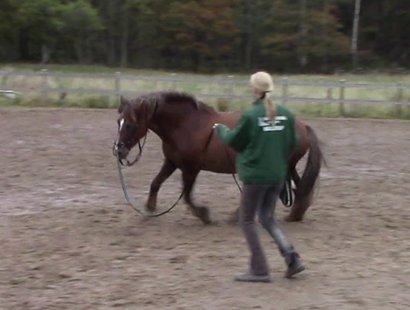Canter is a gait bringing a lot of energy and the hind legs are automatically stepping more in toward the point of weight and lifting the chest. The energy from the canter we can use to improve the trot.
When is it time to start cantering? Does the horse need to be perfect in trot before cantering in the longeing? No, absolutely not! The fact is that the canter may improve the trot so it may even be a good idea to start cantering rather early. For hot horses it may be good to canter regularly so they get used to it and then it does not have to become a big deal cantering. However, it is a clear advantage if the horse can trot on the longe (without falling too much out or in) before starting to canter as it will probably not be easier to steer the horse on the circle in canter.
Just like when we started trotting, in the beginning you can just urge the horse on into canter. However, you should add a voice command to as soon as possible get proper transitions with a jump into canter and just not running and falling into it. I also make a little curtsy i my hips in the transition, the same I would do on the horse if riding and starting to canter. It is possible to reinforce the transition by cantering a few strides yourself and keep the pace in your own body. You may give a new vocal command for every stride to help keeping the pace. If the horse can do a quarter in in the trot, then first ask for this and then ask for canter.
If the horse can do a quarter in in the trot, then first ask for this and then ask for canter.
Canter is an excellent gait to get the hind legs in under the point of weight and it also gives extra energy to bring into the trot. Horses with little energy you can canter a lot in the beginning of you training to get energy. It is of course also possible to do canter transitions every now and then when the trot is getting too slow. Then it may be enough to just canter a few strides, discontinue and praise a lot during the first trot steps after the canter when the horse has some more energy. If the horse is hot you can add some canter in the end of the training. After some time they usually calm down when it is getting a habit to canter.

There are different schools regarding canter. Some say you should teach the horse a very calm, collected canter and thus only ask for one stride in the beginning and then discontinue, whereas others want a more forward canter that the horse can actually manage to maintain for a while. The risk of too much collection is that it is getting too heavy for the horse and that it will break free. I am probably more into asking for a bit more speed to maintain the canter for some time. When that is working you can slowly ask for more and more collection and a collected jump into the canter.
Remember
- Canter and quarter in are associated. Galopp och sluta hör ihop.
- Make a canter transition for quarter in. Fatta galopp från sluta.
- Use a voice command and a curtsy in the jump into the canter.